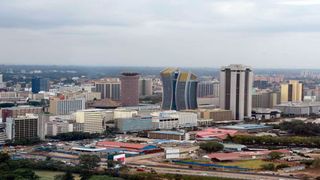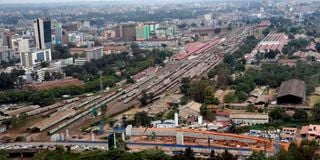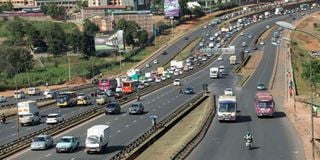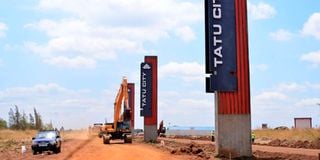
An aerial view of the Nairobi's Central Business District in this picture taken on June 30, 2021.
| Diana Ngila | Nation Media GroupNairobi
Premium
Cities of the future: Why Nairobi has lost its mojo
What you need to know:
- More people are finding life away from the hustle and bustle of the city appealing, meaningful and refreshing.
- Life in Nairobi isn’t for the weak at heart, hence the quiet exodus to the more habitable satellite towns.
Simon Gichimu laughs off the suggestion to settle and work in Nairobi. To the Nakuru-based author, living in Kenya’s capital is not only inconceivable, but untenable as well.
Gichimu, though, was always excited by the prospect of settling and working in the city. After graduating in 2016, he set out to look for an opportunity with media houses in Nairobi.
“With none forthcoming a year later, I took up a teaching job in Nakuru, with the hope that my dream job would come,” he narrates.
Soon, he realised the quality of life in the town was better. For starters, rent was lower than in Nairobi. Gichimu had escaped the rut that is every Nairobi dweller’s dread.
Secondly, food is relatively cheaper in Nakuru, being at the heart of the farming highlands of Rift Valley.
Gichimu says he has more comforts than his peers who secured placement in the city, with twice the compensation.
“Commuting within the town is cheaper and faster. There are no traffic jams in Nakuru,” he adds.
In most neighbourhoods in this town, a one-bedroom house ranges between Sh5,000 and Sh12,000, only marginally higher in Milimani and Section 54. Its equivalent in Nairobi goes for between Sh15,000 and Sh25000. In more affluent estates such as Kilimani, the same unit will leave you as much as Sh60,000 short.
Settling away from the city
There’s a surge in both volume and quality of housing in this town, Gichimu observes. True to form, Nakuru’s urban sprawl has dramatically transformed in recent years, with modern architectural designs replacing the old-fashioned offers from decades ago.
What’s more, new furnished apartments are coming up everywhere in the town to satisfy the demand created by the rising number of high-income earners.
When Nakuru is finally elevated to city status, Gichimu’s newfound dalliance with the town will have been cemented.
‘‘This is where I want to establish myself,” he says.
By establishing himself he probably means settling for good. Or at least live the better part of the productive years of his life. He is not alone.
Japheth Rugut didn’t think twice when he got an accounting job at his home county. He resigned as a teller in a mid-level Sacco in Nairobi and moved back to Bomet County.
“The county is paying me the same amount I was earning in Nairobi, but the expenses here are far less. Unlike before, I’m able to run some personal development projects at home,” Rugut says, noting that the quality of life is more superior in the county than in the capital.
The stories of Gichimu and Rugut mirror those of hundreds of Kenyans, especially millennials, who are excited by the prospect of settling away from the city.

A section of the Nairobi Expressway, which is under construction. The 27-kilometre expressway will run from Mlolongo off Mombasa Road to the James Gichuru junction on Waiyaki Way.
When asked randomly on Twitter about such a possibility, many, like Danzy Mbugua, say they would rather settle in smaller towns, even in rural areas, than in Nairobi,
“In a heartbeat,” Mbugua replies.
Majority of his peers agree.
“I would, and never look back,” replies another user.
It’s several years now since @kush_mwenyewe left the city. He says: “Honestly, I love the tranquility of slow life away from Nairobi.”
The city is becoming less appealing to more people. More than ever before, calls to shift development focus to rural areas have become louder in recent months.
Deputy President William Ruto, for instance, is popularising the “bottom-up” economic model, where people at the base of the economy are empowered for equity.
“The trickle-down model of the economy hasn’t worked for us for many years. We need to change tack,” says DP Ruto.
The DP argues that instead of investing billions of shillings at the top (from Nairobi), the monies should be distributed at the bottom to empower poor people.
“Investing in millions of our jobless youth turns them from a burden to the country to solution providers.”
In his version of economic empowerment model, ODM leader Raila Odinga proposes a seven-point agenda that focuses on turning around the fortunes of rural Kenya as the vehicle to a more prosperous country.
Odinga’s proposals include boosting food production and providing quality healthcare, clean water and electricity. Others are “massive investment in infrastructure”, quality public schools and development planning.
Since 2018, the government has spent billions of shillings in the Nairobi City Regeneration Programme, for instance, to boost access to water and sanitation services in the city and surrounding towns. Estate roads are also being upgraded in some neighbourhhoods.
Observes Odinga: “To ensure more balanced growth, urban regeneration will need to go hand in hand with a deliberate policy of rural transformation that makes rural life more livable and migration to cities unnecessary.”
He says focus should turn from rural-urban migration to rural-urban integration.
Already, some settlements in Kenya are rivalling the original towns. These include Rodi Kopany and Awendo in Nyanza that are competing with Homa Bay town and Migori, respectively.
In Mount Kenya, Chaka is growing faster than Nyeri town while Chogoria is giving Chuka a run for its money. In western Kenya, Bumala and Matayos are emerging as alternatives to Busia town.
Odinga says that even as these towns emerge, the government must “move in to ensure a coordinated and planned growth.”
Doing so, he notes, will create “functional and rich villagers” living dignified and decent lives. “It has been done in other countries. I believe it can be done in Kenya,” he argues.
But how did Nairobi lose its appeal to Kenya’s youth? Why are people fleeing the city every day? Where does Nairobi rank as a city of the future?
The future of work, which is virtual, is also driving the transformation of cities, a development that Jubilee Insurance CEO Julius Kipngetich acknowledges, noting that telecommuting is the future as opposed to a fad.
Thanks to Kenya’s dense mobile telephony landscape, most of the country is now connected to the internet grid. Already, the coverage of 3G network is virtually countrywide, according to data from nPerf, an online resource that maps mobile networks across the world.
Today many Kenyans across the country have access to 4G network, which is supplied by the main telcos Safaricom, Faiba, Airtel and Telkom. Thousands others in Nairobi are connected to the 4G+ signal.
When the 5G network is rolled out in the coming months, Kenya will have joined the league of countries with access to superfast network bandwidths.
To go with the fast internet speeds, co-working spaces such as cafés, garages and parks are coming up across the country. Co-working spaces are considerably cheaper, more functional, efficient and flexible. These attributes make them more preferred to traditional offices, especially by startups.
In Nairobi, the majority of these shared working spaces are located in less crowded and greener zones in the periphery of the city. This helps to rid the Central Business District of human and motor traffic, and the attendant emissions.

The ongoing construction of the Bus Rapid Transit (BRT) on the Thika Superhighway on June 15, 2021.
The rest of the country, though, is catching up fast in the arena of co-working spaces. Nakuru town has Nakuru Box while Eldoret has Kikao64 and Sixty-Four Suites. In Kisumu there’s LakeHub, GulfHub, CoDome and Amazing Kisumu. Swahilipot Hub, MombasaWorks and Anyika are such hubs in Mombasa.
With most employers allowing their teams to work remotely, thousands have given possible relocation away from the city some serious thought.
Kipng’etich observes: “Remote working allows millennials to work from wherever they are. They’re also at liberty to take up multiple jobs for extra income.”
Devolution has resulted in opportunities at the counties, too, a temptation that people like Rugut couldn’t resist. For Gichimu, it’s because of the availability of all government services in Nakuru that he’s staying put. “I rarely travel to Nairobi. In 2020, I didn’t visit the city at all. I have all I need here.”
President Uhuru Kenyatta’s recent UK visit largely focused on projects that touch on sustainability. Out of the Sh20 billion the UK government is advancing to Kenya to support its Big Four agenda, Sh8.7 billion will fund construction of 10,000 green and affordable housing units.
While in London, Uhuru also appealed to the UK business community to seize 10 investment opportunities in Kenya. Worth an estimated $5 billion (Sh542 billion), these projects include the Nairobi Smart Street Lights, the Nairobi Bus Rapid Transport System and the Intelligent Traffic Management System.
The UK is also funding Kenya to the tune of Sh550 million to accelerate its climate change initiatives. Part of the funding is meant to boost renewable energy projects, clean cooling and restoration of forests.
While Nairobi has made significant strides to become a city of the future, insecurity, the rise of informal settlements and the high cost of living have often eroded these gains. UN Habitat says 60 per cent of Nairobi residents live in informal settlements, so when people flee rural areas to the city, the majority end up in slums, leading to an explosion of population in these settlements.
To improve the quality of housing in the city, the government has in the past sought to upgrade informal settlements. The Kibera Slum Facelift Programme in 2012 easily comes to mind. But corruption and lack of adequate community involvement have often seen the refurbished house units end up in the wrong hands or the projects resisted entirely.

Traffic along the Thika Superhighway in this picture taken on December 23, 2020.
No wonder, then, that a Twitter user recently likened Nairobi to Gotham, the city of rogues in Bruno Heller’s crime drama Gotham. In Gotham, anarchy rules supreme. Murders, thievery and exploitation occur almost uninhibited.
While Nairobi hasn’t sunk to Gotham’s depths of debauchery, the rate of crime in the city has struck frightful levels. Criminals are brazenly forcing themselves into vehicles in traffic and stealing from helpless motorists. Deployment of tens of police officers on the streets hasn’t deterred muggers, who are bolder than ever before.
Kenya’s capital may have skidded out of the top 100 most expensive world cities for expatriates to live in, but life in Nairobi isn’t for the weak at heart. A Mercer Cost of Living report in June ranked Nairobi as the 145th most expensive city in the world — the best score in seven years.
Mercer surveys cities using parameters such as the cost of housing, food, transportation, clothing and entertainment. In recent years, the cost of living in Nairobi has been rising by the day, forcing families to survive by a thread.
Tweeted musician Tetu Shani in November last year: “The landlord hiked rent by Sh5,000 and today my wife asked me, ‘Please tell me what’s keeping us in Nairobi?’ I’ve thought about it. Guys, what’s stopping me from relocating to Nakuru?”
If some families had considered a potential move from Nairobi owing to the rising cost of living, the Covid-19 pandemic fit the last piece in the jigsaw in their plan.
Last year, political activist Boniface Mwangi hinted that his family would move out of Nairobi inside two years. “Tunarudi ocha (We’re returning to the village),” said Mwangi, arguing that life in the city wasn’t “sane” anymore for his family of five.
He added: “We want to live in a village (where we can) grow our own food and hang out at the local shopping centre and keep a dog too.”
But is the quality of life elsewhere really as good as in Nairobi? Njango Njenga, a community development professional based in Kilifi, thinks to compare Nairobi to the rest of the country is absurd.
“Housing is affordable. There isn’t much pressure in Kilifi as in Nairobi. It’s only food that’s a bit more expensive here. But the quality of life here is obviously better,” says Njango, who first settled at the coastal county as a student in 2015.
Historically, settlements such as cities around the world developed by accident or happenstance. An elevated ground where dwellers could see the enemy advance, below a mountain, market points or on islands. Not so for cities of the future. The location, design and amenities are all determined deliberately.
With homes, schools, office blocks, a shopping district, nature areas and an entertainment complex, Tatu City is Kenya’s best example of a city of the future. Housing within this 5,000-acre property in Ruiru, Kiambu County, suits all income brackets, according to its developers.

Construction works at Tatu City in September 2017.
Tatu City “represents a new way of living and thinking” that creates “a unique live, work and play environment” devoid of traffic congestion and long-distance commuting.
This Special Economic Zone also provides reduced corporate taxes and customs and excise duty exemptions. There are also VAT benefits and enhanced intellectual property rights.
Already, schools, residential apartments and light manufacturing factories are up and running as life in the city takes shape.
Not so for Konza City, Kenya’s technopolis in Machakos County. Launched in 2013 by President Mwai Kibaki, Konza City would become Africa’s equivalent of Silicon Valley in California, US.
This technology hub 64 kilometres south of Nairobi was marketed as the axis around which Kenya’s development plan, Vision 2030, would turn. Some of the businesses expected to set up base in the 2,000-hectare (5,000-acre) smart city included data centres, software developers and call centres. The city will also feature a science park, shopping malls, convention centres and international schools.
By 2020, operations at the mixed-use high-density city were expected to create 100,000 IT jobs and pump Sh110 billion into the economy.
Grand on paper. Laughable on the ground.
By 2019, the project was already behind schedule. Besides heaps of earth, truckloads of concrete and tens of men at work, there’s hardly much to see at the Sh1.2 trillion project, 13 years later.
Estimates from the Ministry of ICT show that the first phase of the project will be finished in 2030. Kenyans will wait for an additional 20 years for the project to conclude.





